With insider's insight, Wintersteen to lead university she's long served
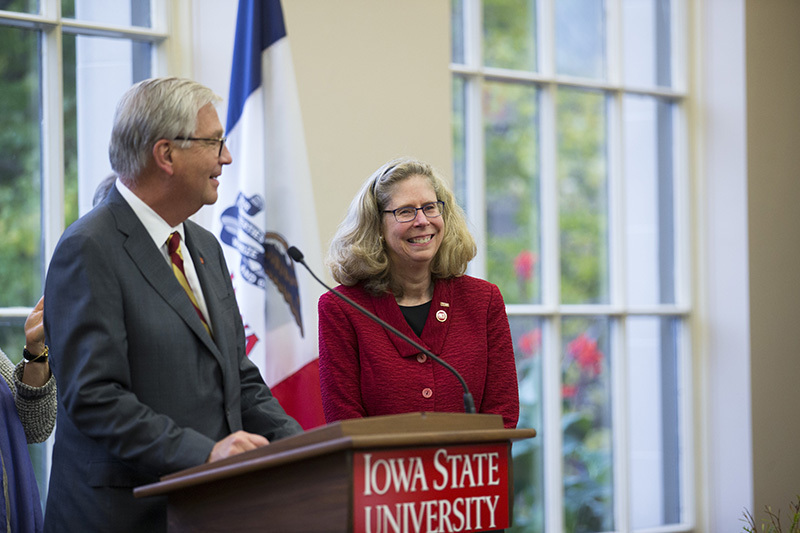
State Board of Regents president Michael Richards introduces Wendy Wintersteen, longtime dean of the College of Agriculture and Life Sciences, as Iowa State's next president, in an announcement at the Memorial Union Oct. 23. Photos by Christopher Gannon.
Iowa State has never had a president with more experience on its own campus than Wendy Wintersteen, but her first task still will be to listen.
After a five-month search, the state Board of Regents on Oct. 23 selected the sole in-house finalist -- Wintersteen, dean of the College of Agriculture and Life Sciences since 2006 -- as Iowa State's 16th president.
When she takes office Nov. 20, she'll be the university's first female president, and the first internal candidate promoted to the position in more than 50 years. She's Iowa State's first president to have earned a doctoral degree from the university, and she has by far the longest history at Iowa State of any past presidential appointment.
"I love this university," Wintersteen said after the announcement at the Memorial Union, which followed an all-day regents meeting. "I care about its future."
Regents president Michael Richards said the board was impressed with Wintersteen's vision for Iowa State, and her experience on campus.
"Dr. Wintersteen is one of the Cyclones' own," he said.
As Agriculture and Life Sciences associate dean for academic and global programs, David Acker has worked closely with Wintersteen. He said she's a strong leader who knows when to compromise and when to "not give an inch."
"This is someone who has demonstrated unbelievable commitment to Iowa State University. You don't have to question whether she has the love for this institution; she's already proven it," Acker said.
Interim President Ben Allen, who has led Iowa State since former President Steven Leath's departure this spring, said he was delighted by the board's pick.
"I have known Wendy a long time and she is a strong, accomplished leader with a proven record of success in the College of Agriculture and Life Sciences. She has a sincere passion for Iowa State. I am confident she will be an exceptional president, and I look forward to working with her to facilitate a seamless leadership transition," Allen said.
Ear to the ground
While she's been at Iowa State for 38 years, Wintersteen, 61, said her first order of business is getting to know every corner of the institution, in part through a series of listening sessions with each college.
"You're not trying to provide the answer to what the issue is. You're simply trying to hear what they have to tell you," said Wintersteen, who as a dean held listening sessions in her college. "What are their stories?"
That effort will benefit from her deep roots at Iowa State -- a progression that includes time as professional and scientific staff, graduate student, faculty and administrator.
"What it's given me is really a clear understanding about Iowa State's people, about its culture and about how it wants to move forward. I think that I'm a very accessible individual because of that path that I've taken. I think it will free up individuals that want to come and visit with me and give me their insights," she said.
Acker said Wintersteen is open to innovation and a "great listener."
"That's not always true of people in leadership positions, so that sets her in a special category as far as I'm concerned," he said.
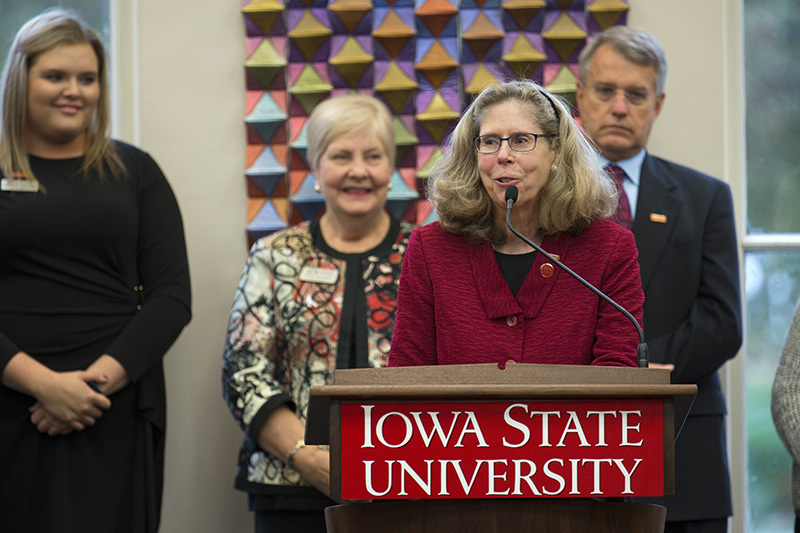
Wendy Wintersteen speaks Oct. 23 about her selection as Iowa State's next president.
Challenges ahead
An interim Agriculture and Life Sciences dean will be named within days, Wintersteen said. Picking her replacement will be one of a series of key hiring decisions she'll face in the coming months, along with College of Veterinary Medicine dean, vice president of extension and outreach, and chief financial officer.
But Wintersteen said her biggest challenge as president will be managing a budget reeling from sagging state support. She has a track record as a fundraiser -- bringing in nearly $250 million in donations in her tenure as dean -- and said she looked forward to continuing the momentum of the ISU Foundation's $1.1 billion "Forever True, For Iowa State" campaign.
"We can not do everything that we need to do at Iowa State University with public monies," she said.
She also emphasized efficiency, saying it was important to prune back unnecessary expenses to focus faculty and staff on their core responsibilities of teaching, research and extension. Iowa taxpayers need to know the university will never waste a dollar, she said.
"That's something we're going to stand up and be proud of every day," she said.
Legislators also want to be assured Iowa State is efficient, but Wintersteen said sharing the impact of the state's largest university also is important.
"They care deeply about the students that we teach because they're the children of their constituents," she said.
Seeking excellence
In her remarks at Monday's announcement and in a Tuesday email to the campus, Wintersteen said her goal is to make Iowa State the nation's best land-grant university. Fundraising will be crucial, allowing for world-class facilities, more scholarships and special experiences for students, she said.
"First of all and foremost, we're about students," she said.
Student government president Cody West, a senior in biology, said Wintersteen is great at relating to students and sincere in her interactions with them.
"The students in her college, especially, are very fond of her. They see her as a visible presence on campus and know their dean is there to support them," he said.
As she did during her public forum as a presidential finalist, Wintersteen pointed to a need to boost entrepreneurial culture across the university and improve inclusiveness on campus.
"I want you to know that I look forward to working with all of you as we create an open, inclusive and welcoming environment where every student who works hard can achieve their full potential," she said.
Benefits open change period for ISU employees is Nov. 1-17
Mark the calendar
- Nov. 1 (9 a.m.): Open change period begins; participation statements available on AccessPlus
- Nov. 3: Live, closed-captioned webcasts (pre/postdoctoral associates (9-10 a.m.); merit (10:30 a.m.-noon); faculty, P&S and supervisory/confidential merit (1:30-3 p.m.)
- Nov. 17 (5 p.m.): Open change period ends
- Dec. 1 (9 a.m.): Benefits confirmation statements available on AccessPlus
- Dec. 8 (5 p.m.): Corrections to benefits statements due at 3810 Beardshear Hall
- Dec. 15 (9 a.m.): Final benefits statements available on AccessPlus
Faculty, professional and scientific (P&S) staff, and supervisory and confidential merit employees have an opportunity to update their ISU Plan benefits during the annual open change period, Nov. 1 through Nov. 17. This year's ISU Plan open enrollment period marks the first time Iowa State's merit employees will participate in the plan, a change that came about last February when the state Legislature and former Gov. Terry Branstad approved changes to the state collective bargaining law. Merit employees were notified of the insurance plan changes this summer.
Same plans, same price, some changes
The 2018 ISU Plan medical and dental benefits remain the same as 2017, with no price increases. Current costs and coverages are available on university human resources' (UHR) benefits page.
Items to note for 2018:
- Merit employees must make medical and dental elections during the open change period
- The plan year for ISU benefits will move to a calendar year beginning Jan. 1, 2018. Previously, benefits changes were implemented annually on Feb. 1.
- Faculty, P&S, supervisory/confidential merit and merit employees may receive ISU Plan credits for waiving medical and dental plans
During this open change period only, the following life insurance programs will require no medical underwriting:
- Employees not currently enrolled in group basic term life insurance automatically will be added to the program at no cost to them
- Eligible employees may enroll in voluntary term life insurance at 1x their annual budgeted salary
- Employees have the choice of two coverage levels for dependent term life insurance
Merit meetings
UHR will hold come-and-go help sessions throughout the enrollment period to help merit staff complete their ISU Plan enrollment in AccessPlus. Employees should bring the following to a session:
- AccessPlus login information
- Names, dates of birth and social security numbers for themselves and all dependents being insured
- Name of primary care physician and obstetrician-gynecologist (optional) for those enrolling in the Blue Advantage (HMO) plan
Meeting dates, times and locations are available online.
More information
UHR is holding live, interactive webcasts with closed-captioning for ISU Plan participants Nov. 3. Intended audiences and times are:
- Pre/Postdoctoral associates (9-10 a.m.)
- Merit (10:30 a.m.-noon)
- Faculty, P&S and supervisory/confidential merit (1:30-3 p.m.)
Log in to https://connect.extension.iastate.edu/benefits, type your name in the "Enter as Guest" heading, then select "Enter Room" to join a webcast. UHR will record the webcasts and archive them on the benefits website following the meetings.
How to make changes
Current ISU Plan participants may review and change their benefits options online through AccessPlus. Benefits will remain the same in 2018 for faculty, P&S staff and supervisory/confidential merit employees who make no changes. However, UHR advises employees to review their benefits and beneficiaries, even if no changes are necessary. Contact the UHR service center, 294-4800, with questions about how to alter benefits online.
The skinny on Iowa State's skeleton sets
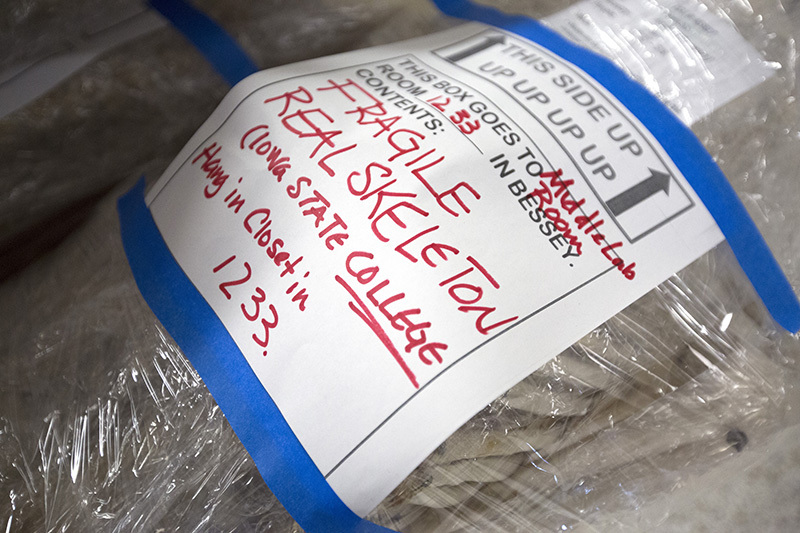
One of the human skeletons of unknown origin used in Iowa State anatomy classes was wrapped for protection in August when it was moved from Science II to the new Bessey Hall addition. Photo by Christopher Gannon.
It's not just a saying. Skeletons actually belong in the closet. But at Iowa State, precisely how some of them got there is a mystery.
Two collections of real human skeletons are used for instruction in the university's biology and anthropology courses. As the course director of the laboratory sessions for biology 255, Fundamentals of Human Anatomy, Carly Manz is the caretaker of one of those skeletal sets.
Anatomy students study the skeletons during the course's two labs on bones, and they're far more valuable as a teaching tool than synthetic skeletons, said Manz, a lecturer in genetics, development and cell biology. Real bones show real variations.
"We all look different," Manz said. "If students go on to any sort of job where they're going to be looking at the health or the bones of individuals, they need to know they're not going to look like the plastic skeletons."
The four anatomy-class skeletons are articulated, meaning they're assembled, wired together with metal rods. They're never taken apart, and when they're moved -- as they were this summer, from Science II to Bessey Hall's new addition -- they must be well-protected in heavy layers of bubble wrap.
Maintaining them is largely a matter of proper storage, Manz said. Skeletons need a somewhat humid environment without direct sunlight to avoid deterioration into brittleness, she said. They also need to hang to be seen, she said.
In other words, something similar to a closet is perfect.
"As long as they're kept in a nice, sealed compartment, they're usually pretty good," she said.
Iowa State's other set of skeletons, used in the anthropology department, consists of unassembled bones stored in individual boxes, Manz said. But that's not the only difference between the two collections.
Much is known about the skeletal material used in anthropology courses. It comes from a large, well-documented collection of skeletal remains accumulated by Stanford University in the early 1900s, which was acquired by the University of Iowa in the late 1990s. A small sliver of that collection is on loan to Iowa State, which in turn has loaned an even smaller sliver to the University of Northern Iowa.
To study forensics, hands-on experience with human bones with known pasts is essential, Manz said. "It's not very valuable to teach them how to estimate the age and sex of skeletons when you don't actually know the answers," she said.
The origin of the four biology skeletons is unknown, however.
Barbara Krumhardt was the anatomy class lab director for 13 years before retiring last year, preceding Manz. When Krumhardt took on the skeletons, there was no information about their history.
"They were just there," Krumhardt said.
When the skeletons, which were once managed by Iowa State's former zoology department, were moved to Bessey this summer, an instructor noted the skeletons had stickers on them bearing the name Iowa State College, the university's name pre-1959. The timing makes sense. Since the mid-20th century, creating new skeletal collections has become ethically challenging.
"It's just much, much harder to get skeletons now," Manz said.
Canvas implementation prepares for full launch in January
The Center for Excellence in Learning and Teaching (CELT) and information technology staff are hard at work preparing for the full launch of the Canvas learning management system (LMS).
Blackboard access ends Jan. 5
All spring 2018 courses that use the LMS will be taught in Canvas. Faculty and student access to Blackboard will end Jan. 5. CELT interim director Sara Marcketti recommends that faculty review their courses in Canvas before leaving for Thanksgiving break to ensure all course materials have migrated successfully to the new platform.
The MyCanvas Teacher at ISU website contains a number of resources to help faculty prepare for spring semester. Recent training modules include self-paced tutorials, webinars and instructions for transitioning courses from Blackboard to Canvas and for downloading grades and other files before access to Blackboard ends.
Student resources
Students can learn more about Canvas features through the MyCanvas Student at ISU website or the "?Help" icon in the left-side navigation bar. The orientation resource includes a series of learning modules to help students adjust to the new system and participate effectively in their courses.
Open labs, 24/7 support available
Iowa State offers 24/7 support for Canvas. Support options are listed in the "?Help" icon in the left-side navigation bar. Students and faculty also may receive Canvas support from the IT Solution Center, 294-4000 (press 2, then 1).
Canvas open labs for instructors will continue through early December. Sessions are held Tuesdays, Wednesdays and Fridays (8-10 a.m. and 1-4 p.m.) in the Parks Library rotunda. Participants should bring a laptop and the work that needs to be accomplished.
"The labs are a great opportunity for faculty to drop in and receive support in migrating their courses, and learn best practices in course design and effective teaching practices," Marcketti said.
For more information on Canvas faculty and staff training, contact CELT staff at celt@iastate.edu. For Canvas support, contact the Solution Center, 294-4000, solution@iastate.edu.
It's Homecoming weekend
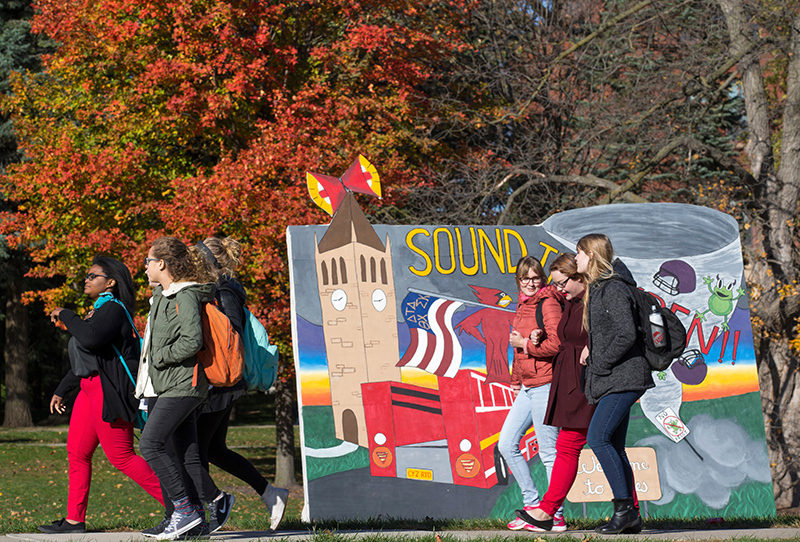
Photo by Christopher Gannon.
(Above) Homecoming banners and fall colors made an always-beautiful walk across central campus even better this week. Below, members of the Iowa State Cyclone marching band helped kick off Homecoming 2017 Sunday afternoon with the second annual parade through downtown Ames. Daily and nightly events continue through Saturday evening; most are free and open to the public.
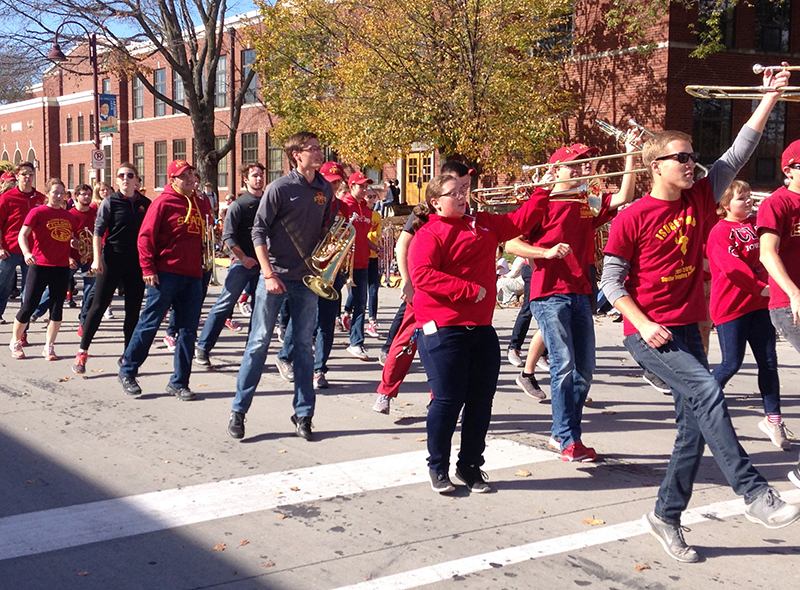
Photo by Anne Krapfl.
Report: ISU faculty more productive in teaching and research
Tenured and tenure-track faculty did 46 percent of the teaching for Iowa State undergraduate students and 90 percent for graduate students last year, according to the annual faculty activity report presented to the state Board of Regents at its Oct. 18-19 meeting in Cedar Falls. The full report is online.
Iowa State faculty reported working, on average, 54.92 hours per week in a survey completed last spring. The survey of all full-time faculty is conducted during odd-numbered years at Iowa's three regent universities.
Iowa State's faculty data is based on 1,208 responses, or 75 percent of those who received it. Clinicians (21 responders) self-reported the longest average work week (56.11 hours), followed by tenured and tenure-track faculty (917 responders, 55.95 hours/week), department chairs and executive officers (48 responders, 55.90 hours/week) and non-tenure eligible faculty (222 responders, 50.33 hours/week).
Efficient teachers
Senior vice president and provost Jonathan Wickert told board members that over the last decade of enrollment growth, the volume of teaching done, measured in student credit hours, increased 71 percent, while faculty appointments of all types increased 43 percent. The result is a 19 percent greater teaching responsibility per faculty member.
Wickert noted that Iowa State is seeing not only greater efficiency, but also better teaching effectiveness, as measured by three student outcomes over the same decade: one-year retention (increased from 84.9 to 87.5 percent), four-year graduation rate (from 35.3 to 46.4 percent), and six-year graduation rate (from 65.6 to 74.3 percent).
Who teaches Iowa State students?* (percentages)
|
|
Undergraduate |
Graduate |
Professional |
All student credit hours |
|
Tenured |
33.4 |
69.8 |
66.8 |
37.0 |
|
Tenure-track |
12.8 |
20.0 |
15.3 |
13.4 |
|
Subtotal |
46.2 |
89.8 |
82.1 |
50.3 |
|
Non tenure-eligible |
41.0 |
10.2 |
17.9 |
38.1 |
|
Graduate assistant |
12.8 |
0.0 |
0.0 |
11.5 |
|
Total |
100 |
100 |
100 |
100 |
*Percentages of student credit hours taught, fall semester 2016
Wickert told board members that Iowa State faculty also are more productive in their research programs. One way to assess this is in the "marketplace of ideas at work" -- external funding invested in ISU researchers' work. Faculty secured $244 million in external funding in the fiscal year that ended June 30 -- about 40 percent more than the general university appropriation from the state for the same time. Wickert noted that, on average, tenured and tenure-track faculty each brought in roughly $180,000 in external funding last year, up from five years ago when that average was about $130,000.
"Just as faculty effectiveness in teaching has increased, their effectiveness in research has not been diminished and, in fact, has grown during that same time period," Wickert said.
How ISU faculty spend their work week (percentages)
|
Activity |
Tenured/T-T |
Non tenure-eligible |
Clinician |
Chair/DEO |
|
Student instruction/advising |
40.1 |
68.4 |
29.8 |
18.9 |
|
Scholarship, research, creative work |
38.4 |
14.8 |
6.8 |
16.3 |
|
Community outreach, extension |
4.1 |
2.8 |
6.1 |
4.0 |
|
Clinical work |
1.5 |
3.3 |
47.0 |
0.0 |
|
Professional development |
1.6 |
1.9 |
1.2 |
3.0 |
|
Administration/service |
14.3 |
8.8 |
9.1 |
56.8 |
|
Total |
100 |
100 |
100 |
100 |
The survey process
Iowa State administered the survey over eight weeks last spring. Surveys were emailed from Faculty Senate president Jonathan Sturm to all full-time faculty, with one-eighth of the faculty receiving it in each of eight weeks. No surveys were sent spring break week or the week before. These groups didn't receive a survey: administrators at the rank of dean and above; faculty on long-term disability, professional development assignments or in phased retirement.
Of 1,612 surveys distributed, 1,330 were returned (an 82.5 percent response rate). But seven were incomplete and another 115 were removed from the analysis because the faculty member was ill or on vacation for at least part of the week. The purpose was to determine faculty activity during a full workweek. This left 1,208 usable surveys.
Executive director Mark Braun
The board unanimously approved a three-year appointment for Mark Braun as executive director of the board, effective Nov. 1. Braun has served as the board's chief operating officer since December 2015, but has worked in the regents system since 1998. His current salary is approximately $240,000, according to Richards.
Braun's salary will be $154,300, the amount allowed by Iowa Code. Board members approved a "recruitment incentive" of $185,000, to be paid in 25 percent increments 30 days and six, 12 and 18 months into Braun's term.
Richards said the COO job will not be filled. That decision and other administrative changes will contribute to a savings of approximately $300,000.
Richards said a committee of board members conducted the search after the board opted to not hire a search firm. He said the committee assessed 42 applications and interviewed five semifinalists. He said Braun emerged as the "far superior" candidate and is "uniquely qualified," in part because of his institutional knowledge and 20-plus years working in the system. The full board interviewed Braun Oct. 18.
Other business
In other Iowa State-related decisions, the board approved naming the Business college the Debbie and Jerry Ivy College of Business, in recognition of a $50 million gift from the Ivys announced last month.
The board also gave the university a green light to begin planning three projects:
- An estimated $750,000 of renovations at the Knoll, the president's residence. Improvements could include door repairs, replacements and modifications; hardwood floor and carpet replacement; kitchen updates; rear deck replacement; hall and bathroom fixture and finishes updates; and painting. Funding sources would be private gifts and university funds.
- Improvements (flexible, multisport layouts; lighting; irrigation and support facilities) to 37 acres of recreation fields east of Jack Trice Stadium. The estimated cost, $8 million to $12 million, would be funded by recreation services funds.
- An estimated 50,000 square feet (one or more new buildings) for poultry teaching and research at the poultry science farm on South State Avenue. The estimated cost, $5 million, would be paid with private gifts.
Celebrate Halloween at these campus events
Fans of Halloween who can’t get enough of the holiday, take heart. Campus groups will host Halloween events over three nights next week. Admission is free and the public is welcome at all events.
Sunday, Oct. 29, 5-7 p.m., Memorial Union South Ballroom
Greek Trick or Treat
A family-friendly indoor event hosted by ISU sorority and fraternity chapters. Activities include bag toss, limbo, face painting, Halloween bowling and more, appropriate for children in kindergarten through fifth grade. All participants are encouraged to dress up in costumes. A costume contest will begin at 6 p.m., with prizes awarded for the best children’s costumes in these categories: funniest, scariest, cutest and most creative.
Monday, Oct. 30, 7:30 p.m., Tye Hall, Music
Octubaween
A fun performance featuring Halloween and tuba-inspired music performed by a band of tubas, euphoniums and trombones, directed by assistant director of bands Christian Carichner. The performance includes skits, costumes and candy. Those attending are encouraged to come in costume.
Tuesday, Oct. 31, 7-8 p.m., 2019 Morrill
Ghost Stories of Iowa State
University Museums interpretation specialist David Faux will share haunted stories from the university’s history. Museums staff are guardians, he said, of more than two dozen accounts of creepy activity on campus. Attendees are welcome -- but not required -- to wear costumes. If time permits, audience members may be able to share additional stories of ISU abnormal activity.
